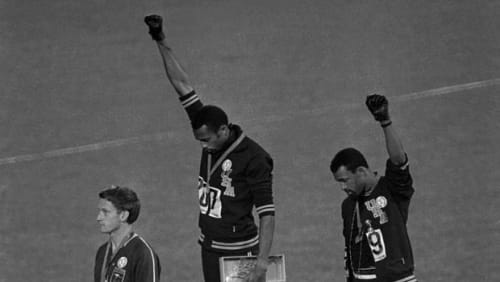At the High Museum of Art in Atlanta, artist Glenn Kaino is offering a fresh take on one of the 20th century’s best-known images: Tommie Smith and John Carlos on the Olympic medal stand in Mexico City in 1968 — a moment frozen by a snapshot. A raised-fist salute, flattened in a photograph, has been given additional depth and meaning in Kaino’s art.
He reproduced casts of Smith’s right arm, evoking both the backbone of a movement, and a flowing wave of power. “Those arms are Tommie’s arms, but they represent all of our arms,” Kaino said.
“It’s more nuanced. It’s more textured, more layered,” said correspondent Jim Axelrod.
“Yes. And that’s where our humanity lies, in the nuance.”
When Tommie Smith himself looks at the iconic photograph, what does he see?
“Look at that young man’s face. Look at it. It looks like he’s saying, ‘Why am I up here?'”
“Is that the proudest moment of your life?” Axelrod asked.
“You better believe it, buddy,” he replied. “But it was one of the saddest moments in my life, too. It’s sad that a young man had to do that.”
1968 remains among the most turbulent years in American history, including on the sports field. At the Summer Olympics in Mexico City that year, U.S. athlete Tommie Smith won the 200-meter; fellow teammate John Carlos came in third.
“I had the gloves because I knew I was gonna use the gloves, but I didn’t know in what fashion,” Smith said. “And that’s when John and I talked about the idea of a victory stand.
“Everything was representative. Shoes, the idea of poverty; the black socks are, of course, power in blackness; the glove represented sacrifice and strength; the wreath in the left hand, the idea of peace, as an olive branch.”
“Right hand’s up with a fist, left hand’s holding an olive branch,” said Axelrod. “Fifty years later, any regrets?”
“No way. No way,” Smith replied.
Which is why Smith is seen as a hero to so many, because he and Carlos were banished from the Games — sent home. The son of a sharecropper, an ROTC student at San Jose State, and a multiple world-record holder, was shunned. He couldn’t even find a job.
He said, “It was a moment of truth for me.”
How important was the moment? Nelson Mandela found it so inspiring he had a photo of the event smuggled into his prison cell on Robben Island.
Sociologist Harry Edwards taught Smith and Carlos at San Jose State — his Olympic Project for Human Rights organized athletes, challenging them to take a stand. “You had athletes who had the courage, who had the vision, who had the platform, to stand up and say, ‘We’re better than this. We can do better than this,'” Edwards said.
He called the photo of Smith and Carlos with their fists raised “the most iconic sports image of the 20th century.”
Half a century later, Edwards advises Colin Kaepernick and others making their own stands.
When asked about his protest, Smith said it was not about denigrating the flag: “No way. Wasn’t about the flag.”
What was it about? “Human rights. Human rights came before the flag,” he said.
Edwards told Axelrod, “For those people who say it was statement against the American flag and America, you don’t do that kind of thing unless you love this country. Otherwise, why not just, you know, get my gold medal, go and see what I can parlay it into, and to hell with the rest of it?”
Philadelphia Eagles Michael Bennett and Malcolm Jenkins are two of today’s NFL players using their platforms to call attention to racial injustice.
“I think everybody, as a young African American athlete, grew up knowing about Tommie Smith and John Carlos,” said Bennett. “I just want every young person who sees the impact of Tommie Smith and John Carlos [to know] they have a voice, that they have a place.”
“But you got to stand up,” said Axelrod.
“You have to stand up, or take a knee.”
Jenkins (who has the Mexico City photo of Smith and Carlos hanging up in his home) raised his own fist in a pre-season game this year.
“We as athletes now stand on the backs of not only John Carlos and Tommie Smith, but all the athletes who’ve risked their careers, to speak up for the things that were not just or not fair in our country,” he said.
Which is what makes Smith and Carlos attractive to both historians and artists. A statue of the athletes’ victory stand sits on the campus of San Jose State. Hang out there almost any day, and it’s plain to see that what may not have been understood in 1968 is now a powerful inspiration.
Edward said, “It was the right temperature, it was the right tenor, it was silent, but spoke volumes. It was the right message. The fact that we’re talking about it a half a century later reminds us of who we are as a people, and what we aspire to be as a nation.”
